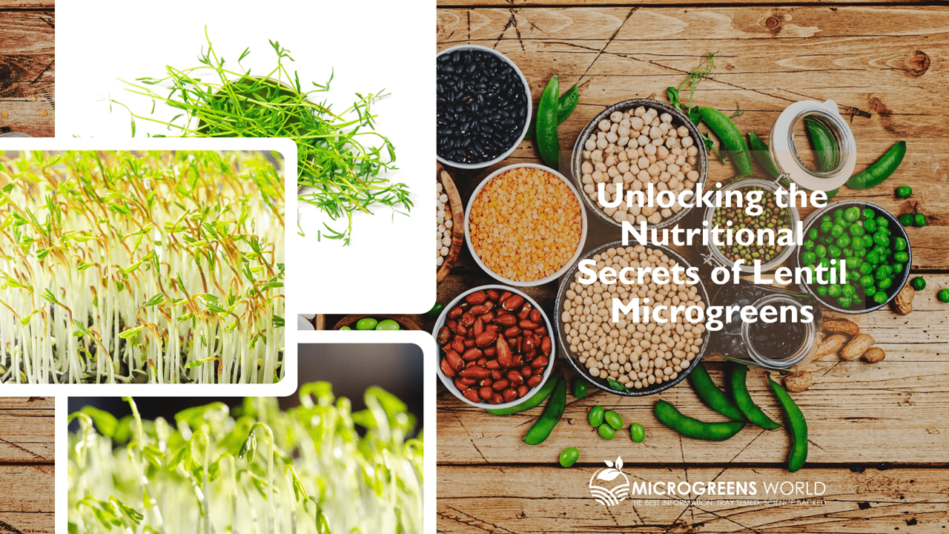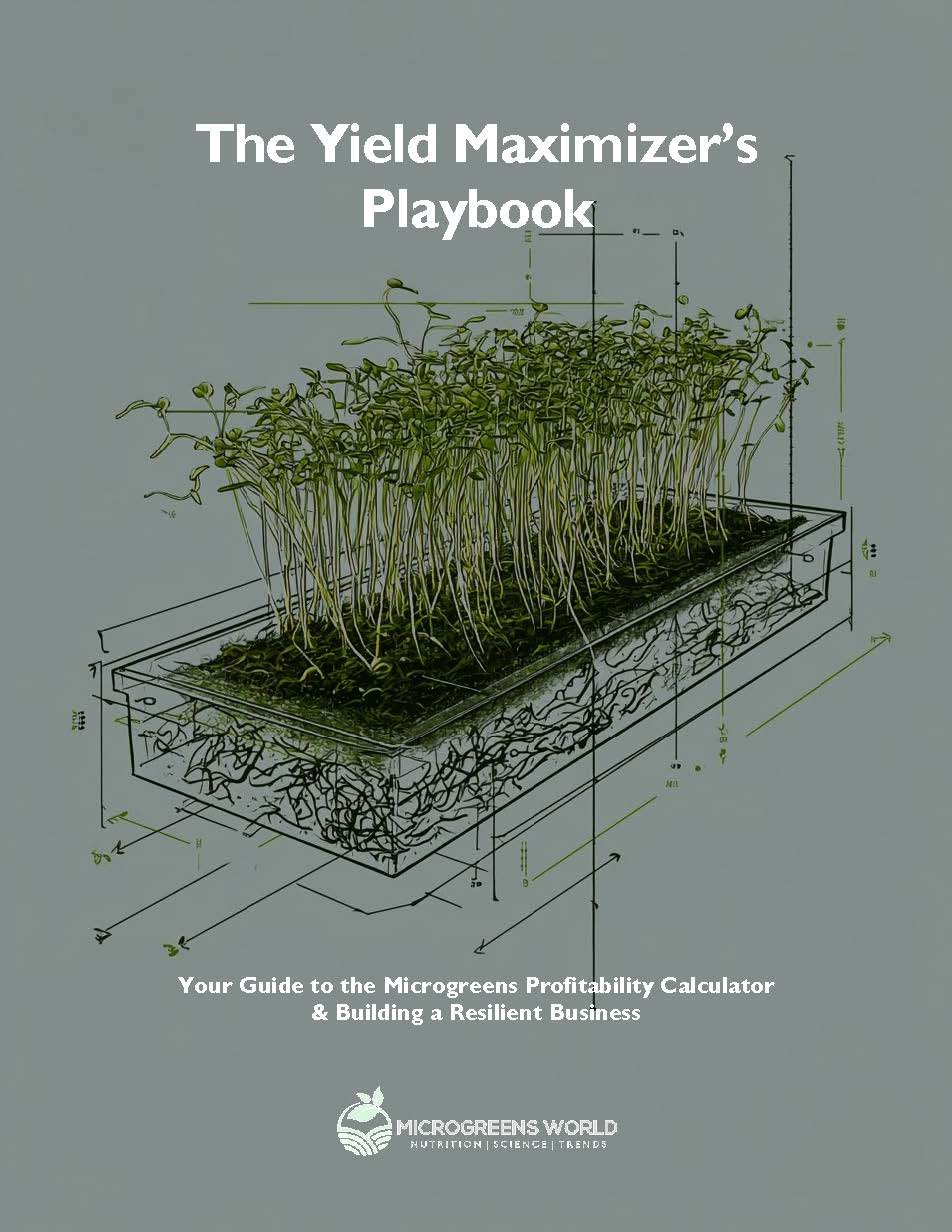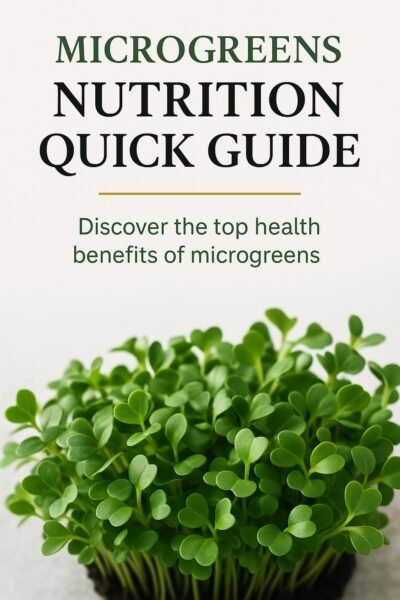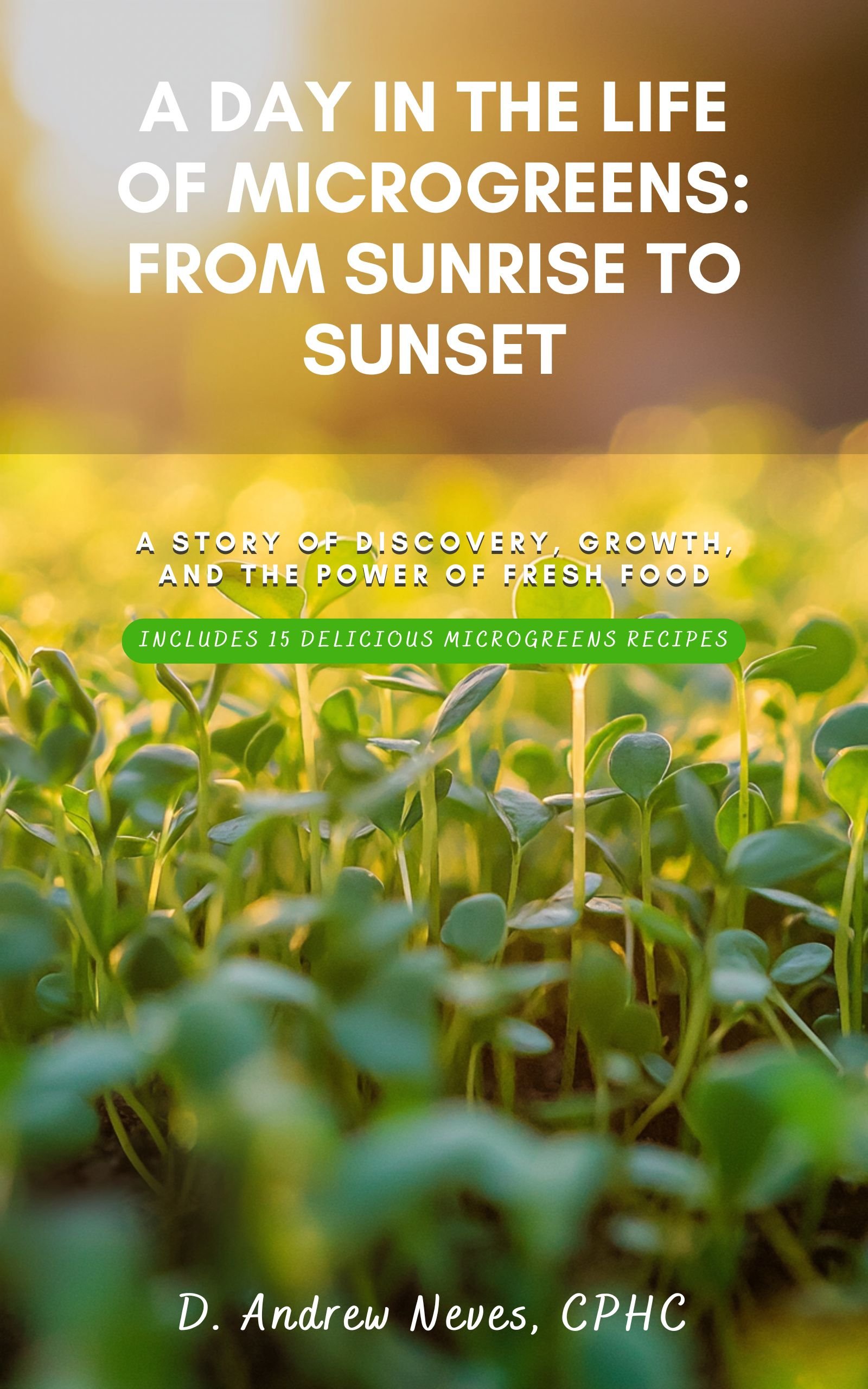A few years ago, I was browsing the vibrant array of fresh produce at my local Wednesday farmer’s market. Amidst the usual suspects of fruits and vegetables, I spotted a small, unassuming tray of sprouts. The sign read “Lentil Microgreens.” Intrigued, I decided to give them a try. Little did I know that this simple decision would begin a transformative journey toward superior health and wellness.
As a board-certified nutrition health coach, I’ve always been fascinated by the power of food as medicine. But nothing prepared me for the nutritional powerhouse that is lentil microgreens. These tiny, tender shoots, barely two weeks old, are a treasure trove of vital nutrients.
Lentil microgreens are impressive muscle-building plants. Vitamin C (18.33%) and a robust B-complex provide for cell and blood health, energy production, and other essential body systems. They are rich in protein (17.92%), boasting 17 of the 20 amino acids and 8 of the 9 essential ones, including leucine (0.63g), arginine (0.61g), and serin (0.50g). The array of minerals also supports bone and skeletal health, iron (17.83%), phosphorus (13.84%), zinc (13.73%), copper (39.11%), and manganese (22.00%).
The more I delved into lentil microgreens nutrition, the more I was astounded. There was food that was nourishing but also versatile and sustainable. It was a revelation that changed my approach to diet and health, and it could do the same for you.
In this post, we’ll explore the remarkable nutritional profile of lentil microgreens, their health benefits, and how you can incorporate them into your diet.
Whether you’re a health-conscious consumer, a home gardener, a gourmet chef, or someone looking to enhance their diet, this guide is for you.
So, let’s embark on this journey together and unlock the secrets of lentil microgreens nutrition.
Key Takeaways
- Lentil microgreens have exceptional protein content at 17.92%, providing 17 amino acids, including 8 essential ones.
- Rich in vitamin C (18.33%) and B-complex vitamins supporting cell health, blood formation, and energy production.
- Provides iron (17.83%) and minerals crucial for bone health, skeletal strength, and overall body function.
- Contains leucine, arginine, and serine amino acids essential for muscle building, recovery, and tissue repair.
- Ideal for vegetarian and vegan diets, offering complete nutrition in versatile, sustainable, easy-to-grow form.
INTERESTED IN MICROGREENS?
Join the community
Join more than 50,000 other health-conscious individuals and couples who visit our site and receive weekly emails from us to help them grow more microgreens to live healthier and longer lives.
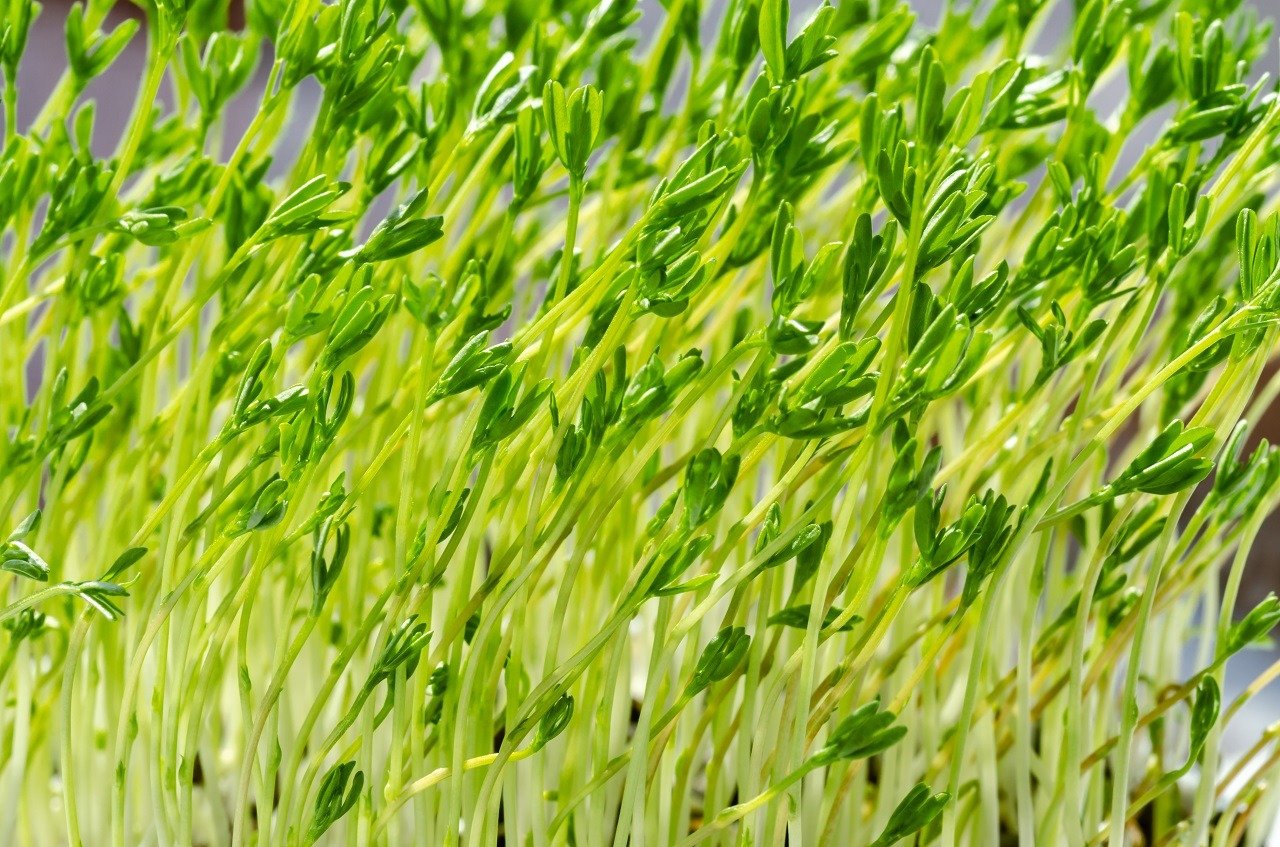
Lentil Microgreens: Overview and History
From the earliest times of our history, lentils are thought to have come from the Mediterranean or Near East regions, where they were used as a food source for our ancestors. They were among the first crops to be domesticated, with archaeological evidence of lentils dating back to 13,000 BC.[9]
| Scientific Name | Lens culinaris |
| Common Name | Lentil |
| Plant Family | Fabaceae |
| Etymology | The name “lentil” comes from the Latin word for “lens,” which refers to the seed’s shape. |
The major diversity center of the local lens culinaris and their ancestor l. culinaris ssp. Orientalism is considered a part of the Middle East. From there, lentils spread to Europe, the Middle East, North Africa, and the Indo-Gangetic Plain.
In the Middle East, North Africa, and Europe, as well as on the coast of the Mediterranean, lentils are grown in one or more varieties. Spanish and Portuguese explorers introduced them to the Americas in the early 16th century.
As for lentil microgreens, they are a relatively recent addition to the culinary scene. These tiny, nutrient-packed plants are harvested after the first leaves have developed. They are a great source of protein, fiber, and resistant starch, a healthy carb that burns fat and boosts metabolism. Lentil microgreens are rich in proteins and minerals, especially iron and magnesium, as well as vitamins B and C.
Varieties of Lentils
There are several varieties of lentils, each with its unique characteristics. Some of the most common ones include:
| Green Lentils | These lentils are the most widely eaten type. They have a peppery taste and hold their shape well during cooking. |
| Red and Yellow Lentils | These lentils are split and cooked quickly. They’re commonly used in dishes like Indian dals. |
| Puy Lentils | These French lentils have a blue-green color and a slightly peppery taste. |
| Beluga Lentils | These are small, black lentils that have a rich flavor and hold their shape well during cooking. |
| Brown Lentils | These are the most common variety in the United States. They have a mild flavor and hold their shape well after cooking. |
There are hundreds of plants, herbs, roots, and fruits you can grow and eat as microgreens. Explore my post “Top 30 Microgreens You Can Easily Grow Indoors.”
Lentil Microgreens Nutrition Facts
Lentil microgreens are a great source of vitamins, minerals, and amino acids. They’re also an excellent way to serve a healthy meal to friends and family who may be vegan or vegetarian.
According to the USDA Food Database, lentil microgreens are packed with nutrients. Here’s everything you need to know about lentil microgreens nutrition info;
| Name | Amount | Daily Value | % Daily Value |
|---|---|---|---|
| Water | 67.3 g | ||
| Energy | 106 kcal | ||
| Energy | 444 kJ | ||
| Protein | 8.96 g | 50 g | 17.92% |
| Total lipid (fat) | 0.55 g | 78 g | 0.71% |
| Ash | 1 g | ||
| Carbohydrate, by difference | 22.1 g | 275 g | 8.04% |
| Calcium, Ca | 25 mg | 1300 mg | 1.92% |
| Iron, Fe | 3.21 mg | 18 mg | 17.83% |
| Magnesium, Mg | 37 mg | 420 mg | 8.81% |
| Phosphorus, P | 173 mg | 1250 mg | 13.84% |
| Potassium, K | 322 mg | 4700 mg | 6.85% |
| Sodium, Na | 11 mg | 2300 mg | 0.48% |
| Zinc, Zn | 1.51 mg | 11 mg | 13.73% |
| Copper, Cu | 0.352 mg | 0.9 mg | 39.11% |
| Manganese, Mn | 0.506 mg | 2.3 mg | 22.00% |
| Selenium, Se | 0.6 µg | 55 mcg | 1.09% |
| Vitamin C, total ascorbic acid | 16.5 mg | 90 mg | 18.33% |
| Thiamin | 0.228 mg | 1.2 mg | 19.00% |
| Riboflavin | 0.128 mg | 1.3 mg | 9.85% |
| Niacin | 1.13 mg | 16 mg | 7.06% |
| Pantothenic acid | 0.578 mg | 5 mg | 11.56% |
| Vitamin B-6 | 0.19 mg | 1.7 mg | 11.18% |
| Folate, total | 100 µg | 400 mcg | 25.00% |
| Vitamin A, RAE | 2 µg | 900 mcg | 0.22% |
| Vitamin A, IU | 45 IU | ||
| Fatty acids, total saturated | 0.057 g | 20 g | 0.29% |
| Fatty acids, total monounsaturated | 0.104 g | ||
| Fatty acids, total polyunsaturated | 0.219 g | ||
| Threonine | 0.328 g | ||
| Isoleucine | 0.326 g | ||
| Leucine | 0.628 g | ||
| Lysine | 0.712 g | ||
| Methionine | 0.105 g | ||
| Cystine | 0.334 g | ||
| Phenylalanine | 0.442 g | ||
| Tyrosine | 0.252 g | ||
| Valine | 0.399 g | ||
| Arginine | 0.611 g | ||
| Histidine | 0.257 g | ||
| Alanine | 0.356 g | ||
| Aspartic acid | 1.43 g | ||
| Glutamic acid | 1.26 g | ||
| Glycine | 0.319 g | ||
| Proline | 0.356 g | ||
| Serine | 0.495 g | ||
Table: Lentil microgreens nutrition facts
Nutrients Found in Lentil Microgreens
Lentil microgreens are a nutritional powerhouse packed with various essential nutrients. They are particularly rich in providing a substantial portion of the recommended daily intake.
This analysis focuses on the nutrients in lentil microgreens that provide more than 9.99% of the Recommended Daily Intake (RDI). Below are the most potent nutrients found in lentil microgreens.
| Protein (8.96g, 17.92%) | Protein is a crucial nutrient for the body, playing a vital role in building and repairing tissues, making enzymes and hormones, and supporting overall growth and development.[15] |
| Carbohydrates (22.1g, 8.04%) | Carbs are the body’s primary energy source. They are broken down into glucose, which the body’s cells use for energy.
Although the Total Lipid (Fat) content is low (0.55g per 100g serving), it’s essential to note that fats are a necessary part of the diet. They provide energy, support cell growth, protect organs, and help the body absorb certain nutrients. |
| Minerals – The Ash content (1g per 100g serving) represents the total mineral content in lentil microgreens. Minerals are vital for health, bone health, muscle function, hydration, and several other physiological processes. | |
| Iron (2.7mg, 17.83%) | Iron, which in red blood cells is a substance that carries oxygen from the lungs and transports it throughout your body, is an essential component of hemoglobin. |
| Phosphorus (173mg, 13.84%) | Phosphorus is vital to bone formation and teeth. It plays a part in the body’s energy metabolism and regulating pH levels. |
| Zinc (1.51mg, 13.73%) | Zinc plays a vital role in immune function, wound healing, and cell growth. |
| Copper (0.352mg, 39.11%) | Copper forms red blood cells, connective tissues, and iron metabolism. |
| Manganese (0.506mg, 22.00%) | Manganese is vital for bone health, wound healing, and metabolism. |
| Vitamins | |
| Vitamin C (16.5mg, 18.33%) | In addition, vitamin C is a potent antioxidant that increases the level of antioxidants in your blood. This may lower the risk of serious illnesses such as heart disease. The RDI for Vitamin C is 90mg for men and 75mg for women, so lentil microgreens provide about 22.2% of the RD for women. |
| Thiamin B1 (0.228mg, 19.00%) | Thiamine is necessary for the proper function of the heart, muscles, and nervous system as it facilitates the conversion of food into energy. |
| Pantothenic acid B5 (0.578mg, 11.56%) | Pantothenate acid is essential for the metabolism of food, which in turn serves as a means to produce hormones and cholesterol. |
| Pyridoxine B6 (0.19 mg, 11.18%) | Vitamin B-6 produces neurotransmitters and helps regulate mood and sleep patterns. |
| Folate B9 (100µg, 25.00%) | Folate is indispensable to the growth and development of cells and prevents congenital disabilities in women during pregnancy. |
| Amino Acids – Lentil microgreens have 17 of 20 amino acids and 8 of 9 essential ones.[3] | |
| Leucine (0.628g) | Leucine is an essential amino acid in the liver, adipose, and muscle tissue. It is used to promote muscle protein synthesis and muscle growth. |
| Arginine (0.611g) | Arginine is an amino acid that’s supposed to help build proteins in the body. It’s releasing a substance from your blood as well: Nitric oxide. Nitric oxide expands blood vessels in the bloodstream, which may help certain circulatory conditions. |
| Serine (0.495g) | Serine is a non-essential amino acid used in the biosynthesis of proteins. It is also used in the biosynthesis of purines and pyrimidines. |
This analysis shows that lentil microgreens are a significant source of copper, B vitamins, and amino acids. Including these in your diet can help meet a substantial portion of your daily nutrient requirements.
NOTE: See the References below for more accurate and specific analyses of lentil microgreens performed in food laboratories.
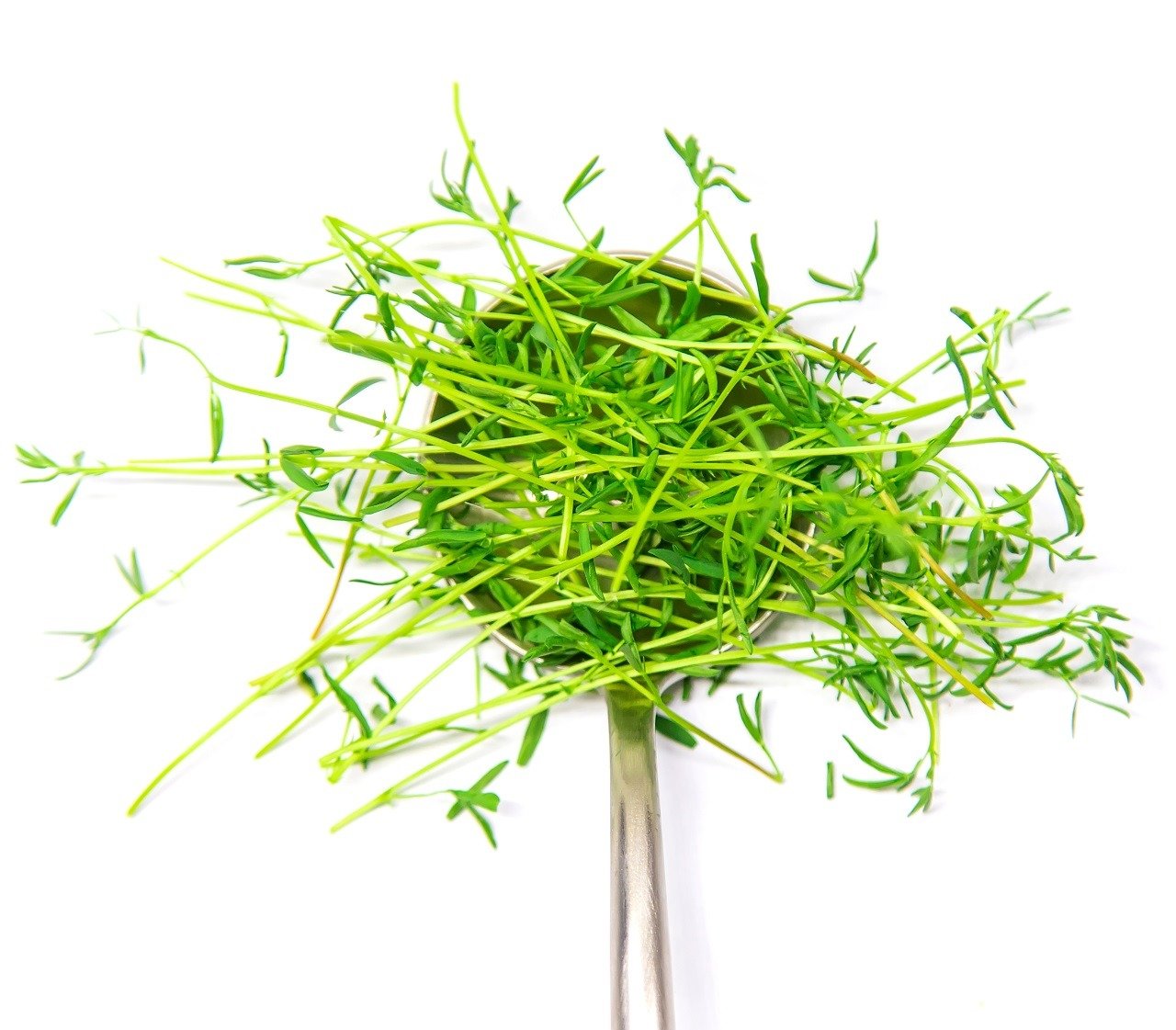
Lentil Microgreens Health benefits
Based on the previous nutritional and research papers I found (see research [5]), here is a summary of the health benefits of Lentil Microgreens:
| Lowers risk of cancer | Despite not much research, a growing body of evidence suggests that lentil microgreens might help reduce the risk of various cancers. Research shows that lentil microgreens contain many antioxidants and anti-carcinogenic compounds, which, if consumed sufficiently, can slow down or stop the progress of cancerous cells. |
| Stabilize blood sugar | The vitamin B6 in lentil microgreens will balance the glucose levels in your bloodstream, preventing excess sugar from building up. This is good news for people who suffer from diabetes or insulin resistance. |
| Antioxidant Properties | Lentil microgreens contain many antioxidants, which can help protect the body from damage by free radicals. Antioxidants reduce the risk of chronic diseases like heart disease and cancer. [10][14] |
| Anti-Inflammatory Benefits | The presence of specific bioactive compounds in lentil microgreens gives them anti-inflammatory properties. This can help in the management of inflammatory conditions like arthritis. |
| Immune Support | The Lentil Microgreen contains a significant amount of vitamin C, which promotes the immune system. It stimulates the production of white blood cells, which are essential for the fight against infections. |
| Blood Health | The microgreens of the lentils are rich in iron which is needed to produce hemoglobin, a protein found in blood cells that transports oxygen throughout the body. |
| Medicinal Properties | Regarding medicinal properties, lentil microgreens’ antioxidant and anti-inflammatory properties can be leveraged for therapeutic purposes. However, more research is needed to understand the potential medicinal uses of lentil microgreens fully. |
Although I strive to provide the most up-to-date information, always consult with your primary healthcare professional before making any changes in your diet.
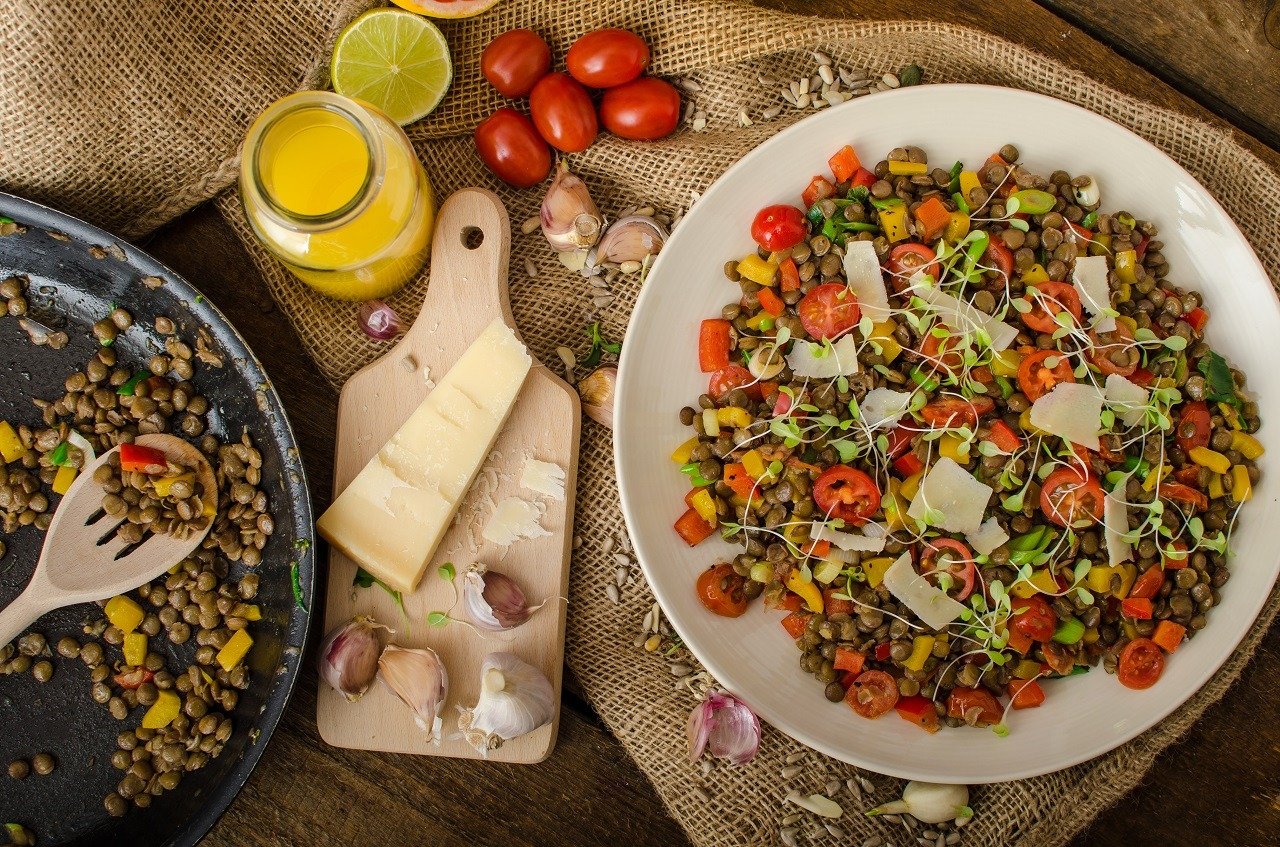
Cooking with Lentil Microgreens
Lentil microgreens are not just a nutritional powerhouse but also a versatile ingredient that can be incorporated into various dishes. Here are some general and unique dishes that you can try:
| Salads | Lentil microgreens can be added to any salad for an extra crunch and a boost of nutrients. They pair well with a variety of vegetables and dressings. For instance, you can try a green lentil salad with microgreens and a creamy garlic dressing, as suggested on Pinterest. |
| Soups | You can add lentil microgreens to your soups for texture and nutrition. A popular recipe is the Red Lentil Soup with Spicy Microgreens, as shared by Bren Haas. |
| Tacos | Lentil microgreens can be used as a topping in tacos. A recipe from Naturally Ella suggests Chipotle Lentil Tacos with Avocado and Microgreens. |
| Stir Fry | You can prepare a stir fry with sprouted lentils, ginger, broccoli, garlic, and red peppers and top it off with lentil microgreens, as suggested by Mamaguru. |
| Pizza | Believe it or not, lentil microgreens can be an excellent topping for your pizza. You can try a Parm & Ricotta Cheese Pizza with Bacon, Pistachios & Microgreens, as suggested by DIYs. |
| Lentil Microgreen Salad with Homemade Dressing | Ingarden suggests a crunchy microgreen lentil salad loaded with lentils, microgreens, and fresh vegetables, topped off with a zesty homemade dressing. |
Remember, the key to cooking with lentil microgreens is to add them towards the end of the cooking process or use them as a garnish to preserve their nutritional content and delicate flavor. Enjoy experimenting with these ideas and discovering your own unique ways to incorporate lentil microgreens into your meals!
Want more ideas on using radish and other microgreens in your daily meals? Read my post, “Mastering the Art – How Chefs Pair Microgreens with Proteins for a Nutritional Boost.“
Lentil Microgreens: Unique Growing Conditions
Growing lentil microgreens is a bit different from growing most microgreens. Here are the unique steps involved in growing lentil microgreens:
| Name | Lentil microgreens |
| Scientific name | Lens culinaris |
| Harvesting | 4-6 days |
| Growth height | Between 2–3” |
| Seed Soaking | Lentil seeds must be soaked for 6-8 hours before planting. This softens the seeds and enhances the germination rate.[12] |
| Planting | Unlike other microgreens, lentil seeds are not buried in the soil. Instead, they are spread evenly on top of the soil and gently pressed in to ensure good contact. |
| Germination | Lentil microgreens have a high germination rate, with up to 95% of seeds germinating within 2-3 days.[6] |
| Lighting | After germination, lentil microgreens should be moved to a light source. They should not be grown in direct sunlight, impacting the flavor and overall quality. |
| Watering | The watering method for lentil microgreens is unique. The grow tray is placed in a larger tray filled with water, allowing the soil to drench from below. This method reduces the risk of mold and is repeated every other day until harvest.[7] |
| Harvesting | Lentil microgreens are ready to harvest within 4 days of planting, significantly quicker than many other microgreens. |
| Storage | After harvest, lentil microgreens should be stored in the fridge for up to 3 days to maintain their best taste and flavor. |
These unique growing conditions make lentil microgreens a quick and easy microgreen to grow at home, even for beginners.
Wrap-Up: Lentil Microgreens Nutrition
In this comprehensive guide, we’ve explored the nutritional powerhouse of lentil microgreens. These tiny greens contain essential exceptionally high in Vitamin B vitamins, copper, and amino acids contributing significantly to your daily nutritional needs.
The health benefits of lentils microgreens are impressive. They range from improving immunity and protecting against heart disease to assisting digestion and possibly preventing diabetes.
We’ve also delved into the culinary uses of lentil microgreens. Their unique, slightly spicy flavor makes them a great addition to salads, sandwiches, and smoothies.
Growing lentil microgreens at home is quick and easy, with some unique steps compared to other microgreens. With a high germination rate and a quick harvest time, they’re an excellent choice for those new to growing microgreens.
Lentil microgreens are a nutritious, delicious, easy-to-grow addition to your diet. Why not give them a try? Start growing your lentil microgreens today and reap their health benefits.
Related Questions
What do lentil microgreens taste like?
The lentil microgreens have a fresh, crisp taste and a slightly sweet and nutty flavor similar to cooked peas. It’s important to note that taste can vary somewhat depending on the variety of lentils and growing conditions. Discover “What Do Microgreens Taste Like?”
Are microgreens considered a superfood?
Microgreens are often considered a “superfood” due to their high nutrient content. While their nutrient contents vary slightly, most varieties are rich in potassium, iron, zinc, magnesium, and copper. Moreover, their nutrient content is concentrated, meaning they often contain higher vitamin, mineral, and antioxidant levels than the same quantity of mature greens. Explore more in my post, “Eat To Meet Your RDA: The 12 Microgreens Vitamins You Need.”
Are lentil microgreens high in fiber?
No, lentil microgreens are not high in fiber compared to lentil, which has 17g (38.215 RDI). Consuming foods high in fiber can help maintain a healthy digestive system and contribute to feelings of fullness, aiding in weight management.
If you want more in-depth information, contact Andrew Neves at andrew.neves@microgreensworld.com.
Share the Guide
We hope you found this guide on Lentil Microgreens Nutrition enlightening and beneficial. If you did, we encourage you to share it with your friends, family, or anyone you think might benefit from this information. You can share it on your social media platforms or even send it directly to someone who might find it helpful.
If you want to learn more about the nutritional benefits of different microgreens, consider signing up for our newsletter. We regularly share informative articles, tips, and recipes to help you maximize these nutritional powerhouses.
Finally, we’d love to hear from you! If you have any questions, comments, or experiences you’d like to share, please leave a comment below. Your insights could help others on their journey to better health.
Thank you for reading, and remember, every step you take toward better nutrition is a step toward a healthier you!
- For a wealth of knowledge, read the post “The Beginner’s Nutritional Guide to Incredible Microgreens” to explore more about microgreens.
- Discover how to grow microgreens. Read this post, “Beyond the Windowsill: Growing Microgreens on Your Balcony or Patio.“
- Interested in the business side? “Harnessing Technology for a Greener Future: A Guide for Microgreens Entrepreneurs.”
INTERESTED IN MICROGREENS?
Join the community
Join more than 50,000 other health-conscious individuals and couples who visit our site and receive weekly emails from us to help them grow more microgreens to live healthier and longer lives.
Research
Here are some authoritative scientific sources that provide support for the nutritional benefits of lentil microgreens:
- Aurther. “How to Grow Lentil Microgreens (Pictures).” GreensGuru, 11 Apr. 2021, www.greensguru.com/how-to-grow-lentil-microgreens/. Accessed 21 July 2023.
- “Ongoing Research on Microgreens: Nutritional Properties, Shelf-Life, Sustainable Production, Innovative Growing and Processing Approaches” https://www.ncbi.nlm.nih.gov/pmc/articles/PMC7353615/. This study discusses the polyamine content in three legumes’ seeds, sprouts, and microgreens, including lentils.
- “Diversity in Phytochemical Composition, Antioxidant Capacities, and Nutrient Contents” https://www.ncbi.nlm.nih.gov/pmc/articles/PMC8420906/. This research explores the phytonutrient diversity of lentil microgreens.
- “Prospects of microgreens as budding living functional food: Breeding and biofortification through OMICS and other approaches for nutritional security” https://www.frontiersin.org/articles/10.3389/fgene.2023.1053810/full. This article discusses the nutritional richness of microgreens, including lentils.
- “The Science behind Microgreens as an Exciting New Food for the 21st Century” https://pubs.acs.org/doi/abs/10.1021/acs.jafc.8b03096. This research paper seeks to stimulate interest in further study of microgreens as a promising dietary component for potential use in diet-based disease prevention and health promotion.
- Hojjat, Seyed Saeid and Galstayan, Merudjan. “Effects of different temperatures and duration on germination of Lentil (Lens culinaris Medik.) seeds.” Russian Agricultural Sciences 38.2, 2012, pp. 101-105., Allerton Press, ISSN 1068-3674, https://doi.org/10.3103/s106836741202019x
- Kara, M., Boydas, M. G., Kara, Y. A. and Ozturk, I. “The Effect of Moisture Content on the Thermal Properties of Red Lentil Seeds.” Transactions of the ASABE 55.6, 2012, pp. 2301-2306., American Society of Agricultural and Biological Engineers (ASABE), ISSN 2151-0040, https://doi.org/10.13031/2013.42488
- Yao, Fanrong, Sun, Chengwen, and Chang, Sam K. C. “Lentil polyphenol extract prevents angiotensin II-induced hypertension, vascular remodeling, and perivascular fibrosis.” Food Funct. 3.2, 2012, pp. 127-133., Royal Society of Chemistry (RSC), ISSN 2042-6496, https://doi.org/10.1039/c1fo10142k
- Lucas, Leilani and Fuller, Dorian Q.. “Lentil: Origins and Development.” Encyclopedia of Global Archaeology, 2014, pp. 4487-4490., Springer New York, https://doi.org/10.1007/978-1-4419-0465-2_2323
- Priti et al. “Diversity in phytochemical composition, antioxidant capacities, and nutrient contents among mungbean and lentil microgreens when grown at plain-altitude region (Delhi) and high-altitude region (Leh-Ladakh), India.” Frontiers in Plant Science 12 (2021): 710812. https://www.frontiersin.org/articles/10.3389/fpls.2021.710812/full
- Kumar, Arun, et al. “Sneak-peek into the chlorophyll content, antioxidant activity, targeted and non-targeted UHPLC-QTOF LC/MS metabolomic fingerprints of pulse microgreens grown under different photoperiod regimes.” Food Bioscience 52 (2023): 102506. https://www.sciencedirect.com/science/article/abs/pii/S2212429223001578
- Mishra, Gyan P., et al. “Morphological, molecular, and biochemical characterization of a unique lentil (Lens culinaris medik.) genotype showing seed-coat color anomalies due to altered anthocyanin pathway.” Plants 11.14 (2022): 1815.
- Alghamdi, Salem S., et al. “Phenological, nutritional and molecular diversity assessment among 35 introduced lentil (Lens culinaris Medik.) genotypes grown in Saudi Arabia.” International journal of molecular sciences 15.1 (2013): 277-295. https://www.mdpi.com/1422-0067/15/1/277
- Lee, So-Young, et al. “Compositional analysis of lentil (Lens culinaris) cultivars related to colors and their antioxidative activity.” Plant Breeding and Biotechnology 5.3 (2017): 192-203.
- Effects of Variety and Crude Protein Content on Nutrients and Anti-nutrients in Lentils (Lens Culinaris) – ScienceDirect, 17 Mar. 2005, https://doi.org/10.1016/j.foodchem.2005.02.001.
